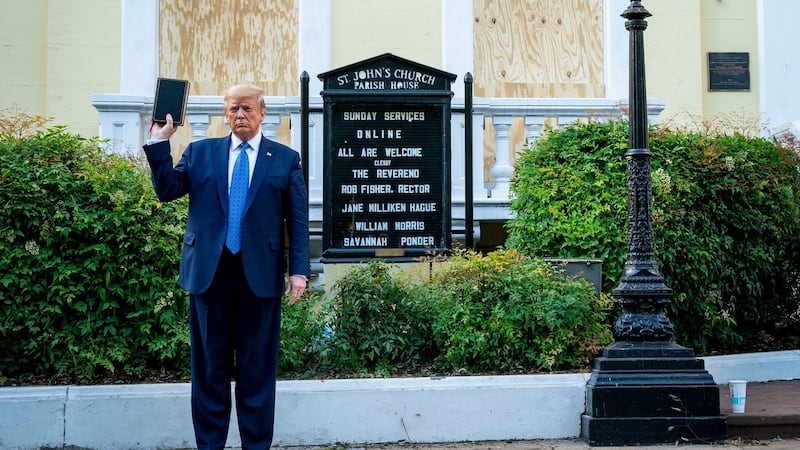All day they came, drawn to downtown Washington DC with its iconic monuments and grand symbols of American power.
From the White House to the Lincoln Memorial to Capitol Hill, demonstrators gathered together under the warm Washington sunshine in the nation's capital.
Thousands of people had come to make their voices heard – holding handmade signs, wearing facemasks, their individual expressions of protest merging now and then with the sporadic collective chants that emanated from the crowds.
Outside St John's Church where Donald Trump had posed with a bible the previous day, men and women of the clergy chatted with young African-American men – all united in their opposition to the message espoused by Donald Trump, their sense that something was deeply wrong in the state of their country.
Many had brought their children to witness America’s cherished first amendment – including the right to free speech and to peacefully assemble – in action.

Lenny Mansell had travelled into DC from Fairfax, Virginia. Wearing a face mask, his eight year-old son Vinny held a sign reading "I can't Breathe," and "Impeach Trump," as he smiled in the sunshine. 23 year-old Rodrigo Devin from Atlanta was in Washington for business. Asked what prompted him to come to the streets, he replied: "If not now, then when…As an African-American, I see that everything is way out of hand. What else are we supposed to do?"
Many of those who marched were students and young adults – a new generation protesting against the same problem of racial injustice that motivated their parents' and grandparents' political activism fifty years ago. Outside the Lincoln Memorial, where Martin Luther King delivered his "I have a dream" speech in 1963, heavily-armed police guarded the giant marble statue of Abraham Lincoln, the president who fought and won a bitter Civil war over slavery. As Lincoln looked on, the crowd dropped to their knees as 7pm approached, calmly wrapping up their protest before the curfew took effect.
Throughout the hours of protests there was one person who has never far from the minds of those gathered in Washington DC yesterday – George Floyd. His death, graphically captured on camera phone as he lay pleading for his life before his body gradually went lifeless, has prompted the demonstrations that have swept America. His name, sketched on the streets and buildings around Washington DC, was chanted again and again. But there were others – Breonna Taylor, a 26 year-old African-American woman who was hit eight times by police bullets after officers burst into her apartment in Louisville, Kentucky, shooting her dead. "Bre-onn-a, Bre-onn-a," the crowd sang as they turned towards Capitol Hill.
While Tuesday was the fifth day of protest in Washington DC, the city saw the largest crowds since the demonstrations began.
Despite Monday’s violence, when police moved to disperse people before the curfew came into effect and the US president engaged in his choreographed appearance in front of St John’s church, the protesters were undeterred.
Indeed, Trump’s grotesque appropriation of religion while law enforcement officials used rubber bullets and pepper spray to move protesters, had seemed to galvanize people.
Many of those demonstrating last night were there for the first time. Bernice, a 22-year-old from Maryland just outside DC, was handing out pre-prepared hotdogs she and her friends had made. Like many, they had been spurred to protest after watching the clashes on Monday night. Asked if she planned to stay out past the curfew, she nodded. "We are not going to be moved from the streets."
As darkness fell, and the 7pm curfew came and went, the crowd outside Lafayette Square began to disperse, some joining a separate protest at Capitol Hill.
Though helicopters whirred over the skies of Washington and police cars patrolled the streets, there were few signs of the violence and looting that marred the protests on Monday night. In a victory of sorts for the demonstrators, they defied the curfew and the police chose not to act, at least in the immediate term.
Unlike Monday, when Trump’s visit to the church dominated the news-cycle and overshadowed the protests, the US president was just a sideshow last night, firing off sporadic tweets from inside the White House as those outside protested in a dignified and peaceful way.
Scenes like the protests in DC last night were replicated across the country, as the number of people protesting swelled. Boston saw some of its biggest demonstrations since the death of Floyd on May 25th, while people took to the streets of Chicago to express their fury at the killing of an unarmed black man. Aerial shots showed thousands of people filling the streets of New York and Los Angeles, in the biggest demonstrations of mass dissent since the anti-Vietnam war and civil rights protests of the 1960s. Monday's scenes of looting appeared not to have been repeated last night.
As America remains at a heightened moment of tension, myriad questions present themselves. When, and how will the biggest mass protests in decades come to an end? What impact will the outbreak of protest at the death of George Floyd have on the presidential election? Will any real reform of the criminal justice system and the legal protections offered to police officers emerge from the present crisis?
What is clear is that the current social unrest gripping America is far from over. Where it goes next is anybody’s guess.










